Imagine waking up to find your life savings halved in 10 minutes. That’s what happened to thousands of traders on January 15, 2015, when the Swiss franc suddenly soared 30% against the euro. Banks lost billions, brokerage accounts imploded, and the currency world learned a brutal lesson: even “safe” bets can backfire spectacularly.
George Soros famously made $1 billion in a day betting against the British pound, but here’s the kicker—you’re not George Soros. The foreign exchange market moves $7.5 trillion daily, yet retail traders often feel like they’re playing chess against a supercomputer. Why? Because between leverage traps and geopolitical curveballs (looking at you, Brexit), this field rewards patience as much as skill.
Think of it like untangling headphone wires while riding a rollercoaster. Big institutions have teams and algorithms. You’ve got coffee, a laptop, and Reddit forums. But that doesn’t mean you’re doomed. We’ll break down real stories—like how oil prices gutted the Canadian dollar in 2016—to show what separates thrill-seekers from strategic players.
Key Takeaways
- Leverage amplifies gains and losses—like using rocket fuel for your lawnmower
- Market shocks (Swiss franc 2015, Brexit) can erase profits faster than a TikTok trend
- Retail traders face steeper odds without institutional tools or risk buffers
- Historical wins (Soros) are exceptions, not blueprints for casual investors
- Success requires managing emotions as much as analyzing charts
This isn’t another “get rich quick” guide. We’re here to unpack the messy reality of currency markets—where discipline beats luck, and every trade tells a story. Let’s dive in.
Introduction
Ever felt like you’re decoding the Matrix while your coffee goes cold? That’s currency markets in a nutshell—full of flashing numbers and hidden patterns. This guide won’t promise Lamborghinis or beachside laptops. Instead, we’re handing you a flashlight for the financial fog.
Why This Exists
We built this roadmap after watching too many smart people get sucker-punched by leverage or Brexit-style surprises. Consider it your cheat sheet for navigating 24/5 markets where central banks move faster than TikTok trends. You’ll learn to spot opportunity without ignoring landmines—like how oil prices turned the Canadian dollar into a rollercoaster in 2016.
Your Toolkit Ahead
Expect zero sugarcoating. We’ll dissect everything from basic terms (what’s a “pip” anyway?) to advanced risk buffers used by pros. You’ll get:
- Real talk about profits versus pipe dreams
- Strategies that adapt when markets pull a GameStop
- Red flags even your broker won’t mention
Think of it as GPS for the $7.5 trillion jungle—where one wrong turn can vaporize accounts, but the right path builds lasting skills. Let’s swap confusion for clarity, one chart at a time.
What is Forex Trading?
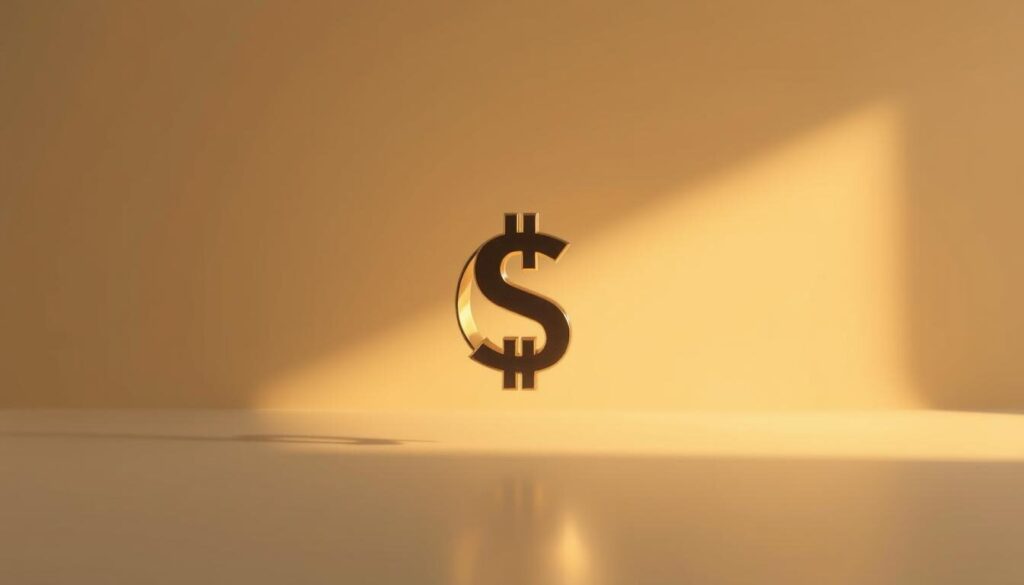
Picture trying to buy gelato in Rome with dollars. That crumpled $20 becomes your first “trade” – swapping one money for another. This global swap meet never closes, where euros, yen, and pounds change hands faster than concert tickets.
Base Coins and Price Tags
Every transaction has two sides – like a seesaw. The base currency sits on the left (what you’re buying), while the quote currency shows the price. EUR/USD = 1.08 means your euro costs $1.08. Think of it as the world’s largest menu board, constantly updating prices for 170+ monetary combos.
Three Ways to Play
Spot deals are like paying cash for today’s gelato – immediate exchange at current rates. Forwards? Booking next summer’s vacation condo. You lock in today’s rate for future needs, useful when companies hedge against wild swings.
Futures take it further – standardized contracts traded on exchanges. Imagine 100 traders betting on December’s oil prices, but for currencies. These tools help big players manage risk, though retail investors often stick to spot markets for simplicity.
Mastering these fundamentals is like learning traffic signs before road-tripping. Without knowing what EUR/GBP means or how forward contracts work, you’re driving blindfolded through monetary rush hour.
Market Overview and Historical Context
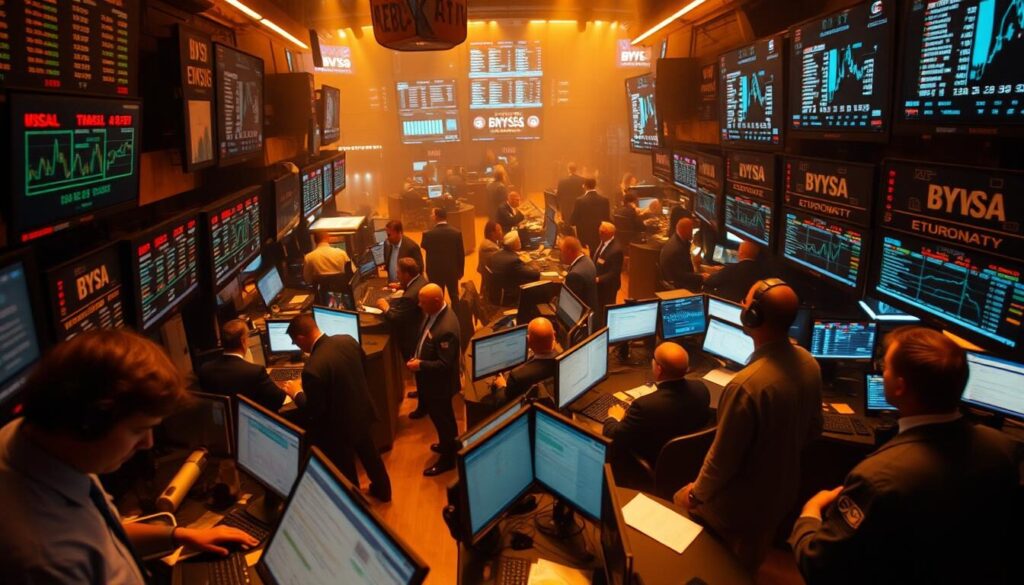
Ever bartered spices for silk on the Silk Road? That’s where currency swaps began—crude but effective. Fast-forward to 1971: Nixon yanked the dollar off the gold standard, turning money into a global game of musical chairs. Today’s markets? A digital colosseum where $7.5 trillion changes hands daily.
The Evolution of Currency Trading
From smoky 1970s trading floors to today’s smartphone apps, the journey’s wilder than a crypto meme stock. Remember when brokers shouted orders through landlines? The 1990s electronic boom changed everything—like replacing carrier pigeons with lasers.
Three game-changers shaped modern markets:
- 1971: Floating exchange rates began—currencies started dancing to supply/demand tunes
- 1996: Online platforms let retail traders join the party
- 2015: Swiss National Bank’s “Francogeddon” proved central banks hold the remote control
Global Trading Hours and Daily Volumes
Markets never sleep—they just pass the baton like a never-ending relay race. Tokyo wakes first, then London, then New York. The sweet spot? When sessions overlap—like Europe and North America high-fiving at lunchtime.
| Market | Open (ET) | Peak Liquidity | Major Pairs |
|---|---|---|---|
| Asia | 7 PM – 4 AM | USD/JPY | 38% of volume |
| Europe | 3 AM – 12 PM | EUR/USD | 28% of volume |
| North America | 8 AM – 5 PM | GBP/USD | 19% of volume |
Pro tip: Trade EUR/USD during London hours—it’s like catching waves when the tide’s just right. But watch central bank speeches—they’re the fireworks that light up (or blow up) the night sky.
Advantages and Risks in the Forex Market
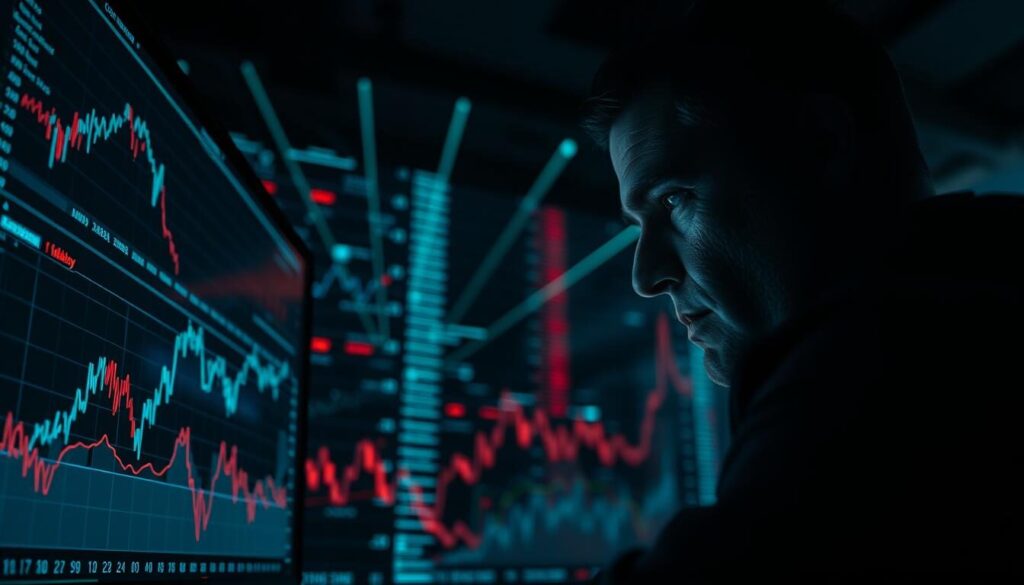
Like trying to ride a unicycle through Times Square at midnight. The currency world offers thrills and spills—but only if you know where the guardrails are. Let’s unpack why some thrive here while others crash faster than a meme stock.
Why Retail Traders Keep Coming Back
Round-the-clock action and low entry costs make this space addictive. Retail players can jump in with $100 and 500:1 leverage—like buying a Ferrari with pocket change. But here’s the kicker: 70% lose money within three months, per UK’s FCA.
Institutions? They’ve got Bloomberg terminals and insider-grade data. Imagine playing poker where they see your cards. Still, small accounts can win by specializing—focusing on predictable pairs like USD/CAD during oil reports.
| Aspect | Retail Traders | Institutions |
|---|---|---|
| Leverage Access | Up to 1:500 | 1:10-1:50 |
| Trade Execution | 0.3-1.5 sec latency | Microsecond speeds |
| Risk Management | Manual stops | Algorithmic hedging |
When the Rollercoaster Derails
Remember FXCM’s 2015 meltdown? Clients owed $225 million after the Swiss franc shock. Leverage turned minor dips into account implosions—like using fireworks to light birthday candles.
Three traps to avoid:
- Overconfidence: Thinking three winning trades = Warren Buffett status
- Platform Roulette: Slippage during news events can skew prices
- Emotional Whiplash: Chasing losses leads to “revenge trading” spirals
Smart players treat leverage like chili peppers—a little adds flavor, too much burns everything. Next, we’ll explore how to build shock absorbers for your account when markets go rogue.
Does Forex Trading Pay?
Picture a casino where blackjack dealers see your cards. That’s currency markets for retail players—exciting tables, stacked odds. While hedge funds score big with billion-dollar plays like yen carry trades, most individuals face tougher math: two-thirds lose money annually according to CFTC data.
Here’s the twist. Big players have advantages you don’t:
| Hedge Funds | Retail Traders |
|---|---|
| Access to interbank rates | Retail spreads (+2-3 pips) |
| Algorithmic hedging | Manual stop-losses |
| 0.01% transaction fees | $7-10 per $100k trade |
Think rocket fuel versus sparklers. Institutions borrow yen at 0.1% interest to invest in higher-yielding currencies—a strategy requiring capital most lack. Meanwhile, the average $500 account? One bad leverage move can erase weeks of gains.
Real talk: surviving requires playing smarter. Focus on liquid pairs during overlap hours when price swings trend predictably. Platforms like regulated brokers offer tools to level the field—economic calendars, swap rate calculators. But remember: no app fixes impulsive decisions when GBP/USD tanks during Brexit headlines.
Can you profit? Sure—like hitting three cherries on a slot machine. Consistently? That’s where discipline enters. Next, we’ll explore strategies that help tilt odds slightly in your favor (no magic bullets included).
Forex Trading Strategies for Different Timeframes
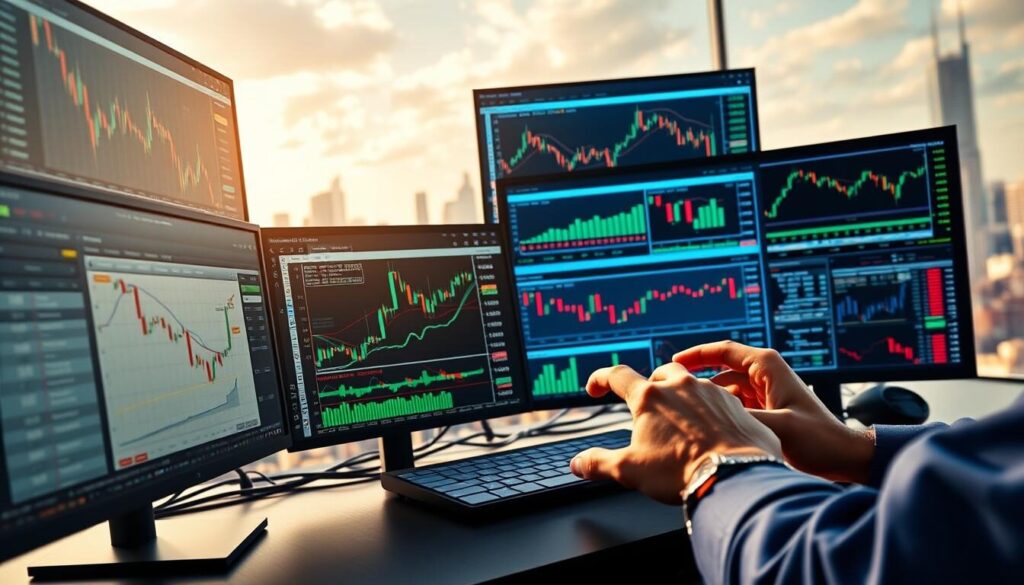
Think of trading styles as different sneakers—you wouldn’t sprint in hiking boots. Whether you thrive on adrenaline or prefer slow burns, matching methods to your schedule and temperament matters. Let’s explore four approaches and how to customize your game plan.
Speed vs. Stamina: Picking Your Pace
Scalpers are the hummingbirds of markets—flitting in/out within minutes, snatching 5-10 pips per trade. Imagine checking prices every 90 seconds like it’s TikTok refresh mode. Day traders? They’re the lunch-break warriors, opening/closing positions before bedtime. Perfect for those who hate overnight surprises.
Swing traders ride waves for days, catching trends like surfers. Position players? Think cross-country road trippers, holding trades for months. One suits spreadsheet lovers; the other needs Zen-like patience.
| Style | Timeframe | Activity Level | Best For |
|---|---|---|---|
| Scalping | 1-15 mins | High | Quick decision-makers |
| Day Trading | Hours | Moderate | 9-to-5 schedule folks |
| Swing | Days | Low | Trend followers |
| Position | Weeks+ | Minimal | Fundamental analysts |
Crafting Your Signature Move
Your strategy should fit like a tailored suit—not off-the-rack. Night owl? Asian session scalping might click. Hate screen-staring? Weekly charts with multiple timeframe analysis could work.
Three questions to start:
- Does volatility excite or exhaust you?
- Can you handle 10 losses before a win?
- Do charts make you curious or queasy?
Mix approaches like a DJ blends tracks. Maybe scalp EUR/USD during London hours but swing trade gold weekly. Demo accounts are your lab—experiment without explosions.
Risk Management and Leverage Considerations
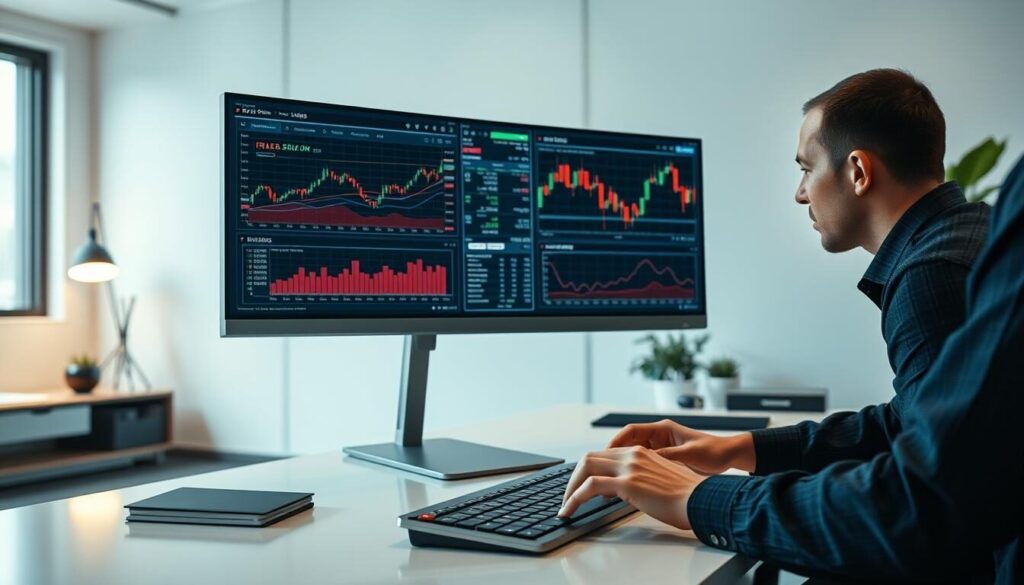
Imagine driving a race car without seatbelts. That’s currency markets when you ignore risk controls. Leverage acts like nitro boost—thrilling until you hit a wall. The 2015 Swiss franc disaster proved even automated stops can fail during extreme volatility. Here’s how to build guardrails for your account.
Managing Leverage and Protecting Your Capital
Using 200:1 leverage is like buying fireworks with a credit card—fun until it’s not. Stick to ratios under 30:1 for most trades. Example: A $5,000 account risking 2% per trade ($100) could handle 10 losses before needing repairs. Institutions use algorithmic buffers; you’ve got discipline.
Utilizing Stop-Losses and Trade Management Tactics
Stop-losses are parachutes—deploy them before jumping. But during the Swiss franc chaos, orders executed 30% below requested prices. Solution? Set stops at technical levels (support/resistance), not round numbers. Sliding stops lock profits as trades move favorably—like upgrading from economy to first mid-flight.
Avoiding Common Psychological Pitfalls
Fear and greed are the Bonnie and Clyde of trading. Ever held a losing position hoping it’ll rebound? That’s denial dressed as strategy. Three mental hacks:
- Treat each trade like a bad Tinder date—cut losses fast
- Track decisions in a journal (emotions reveal patterns)
- Schedule breaks after two consecutive losses
Remember: Markets test patience more than skill. Build systems, not hopes. Your future self will thank you.
Essential Tools and Platforms for Forex Trading
Choosing a trading platform feels like swiping through dating apps—endless options, but only a few real matches. Your tools can mean the difference between gliding through markets or getting stuck in digital quicksand. Let’s cut through the noise.
Choosing the Right Trading Platform
Platforms are your cockpit. Look for three non-negotiables: speed (executes trades faster than TikTok trends), clean interface (no hieroglyphic menus), and tight spreads. MetaTrader 4 remains the Honda Civic of platforms—reliable, customizable, with 9 million daily users. Newer options like TradingView? Think Tesla touchscreens—flashy charts and social features.
| Platform | Best For | Unique Perk |
|---|---|---|
| MetaTrader 4 | Automated strategies | 9,000+ free indicators |
| MetaTrader 5 | Multi-asset trading | Economic calendar built-in |
| TradingView | Visual learners | Social trading chatter |
Leveraging Demo Accounts and Educational Resources
Demo accounts are flight simulators for markets. Most brokers offer $20,000 virtual funds—practice without burning cash. One trader told us: “I crashed six demo accounts before my first live profit.”
Pair practice with learning:
- Weekly webinars dissect real trades (like ESPN breakdowns for currencies)
- Strategy builders let you test “what if” scenarios risk-free
- Platform tutorials explain hidden features (did you know MT4 alerts work while closed?)
Pro tip: Rotate between 2-3 demo platforms. You’ll quickly spot which tools feel like extensions of your brain versus clunky add-ons. The right setup becomes your market sixth sense.
Differences Between Retail and Institutional Forex Trading
Imagine trying to race a bicycle against a Formula 1 car. That’s retail versus institutional currency markets. While both play the same game, the tools, rules, and tracks differ wildly. Let’s break down why your broker’s platform feels like a flip phone compared to Wall Street’s quantum computers.
Information Edge and Data Access
Institutions see markets in thermal vision. They pay millions for satellite images tracking Walmart parking lots or real-time shipping data. Retail traders? You’re squinting at free economic calendars. Major banks trade currencies at 0.0001 spreads through private networks—you get 1.5 pips and crossed fingers.
Execution speed tells the same story. Hedge funds process trades in microseconds using fiber-optic cables. Your home Wi-Fi adds 300 milliseconds—enough time for prices to shift three times. It’s like bringing a slingshot to a drone strike.
Regulatory and Counterparty Considerations
Retail rules feel like training wheels. The FCA caps leverage at 30:1 for you, while institutions borrow at 50:1 through shadow banking. Your broker profits when you lose? That’s counterparty risk biting harder than a caffeine-deprived day trader.
Institutions dance through loopholes you can’t see. They access exotic instruments like NDFs (non-deliverable forwards) for emerging markets. You’re stuck with standard lots and pray spreads don’t widen during news events.
“Retail traders play checkers. We play 4D chess with AI co-pilots.” – Anonymous hedge fund manager
But here’s hope: Smart individuals exploit niche strategies. Focus on less crowded pairs or specific times when algorithms nap. It’s like finding quiet library corners while Wall Street’s robots party elsewhere.
Impact of Global Economic and Political Events on Forex
Global markets react faster than a group chat when someone drops gossip. Currency values swing on headlines like a caffeine-fueled auction. Let’s explore how central bank whispers and election drama shape your trades.
Central Bank Policies and Market Reactions
When the Federal Reserve sneezes, currencies catch colds. Take 2015: Switzerland’s central bank suddenly unpegged the franc from the euro. The franc soared 30% in minutes—brokerage accounts imploded like soda cans under trucks. Rate decisions act as market steroids:
| Event Type | Example | Currency Impact | Duration |
|---|---|---|---|
| Rate Hike | Fed 2022 increases | USD up 4% vs majors | 2-6 weeks |
| QE Announcement | ECB 2020 stimulus | EUR down 2.1% | 3 months+ |
| Policy U-turn | SNB 2015 shock | CHF +30% vs EUR | Instant |
Smart traders stalk central bank calendars like concert ticket drops. Pro tip: Economic calendars flag these events weeks early—your early warning system.
Economic Indicators and Geopolitical Influences
GDP reports are currency report cards. When Canada’s 2016 oil crash hit, the loonie sank 15% faster than a dropped burrito. Geopolitics adds spice:
- Brexit votes turned GBP into a yo-yo
- US-China trade wars made AUD/NZD twitchy
- COVID lockdowns boosted safe-haven JPY
One hedge fund manager told us:
“Trading during elections is like betting on reality TV—outcomes hinge on undecided voters’ coffee choices.”
Track inflation like your Netflix queue. Rising consumer prices often mean rate hikes ahead—which can lift currencies like balloons. But miss a key report? That’s forgetting your mom’s birthday times ten.
Practical Tips to Enhance Forex Trading Profitability
Trading currencies without a plan is like navigating a storm without a compass. The difference between surviving and thriving often comes down to three pillars: clear targets, ironclad rules, and relentless learning. Let’s turn theory into action.
Setting Realistic Goals and Managing Risk
Treat your account like a video game health bar—each loss chips away at your survival odds. Start with the 1-2% rule: Never risk more than $50 on a single play if you’ve got $5,000. Track every move using the expectancy formula:
- Wins: 6 trades netting $200 each
- Losses: 4 trades losing $80 each
- Expectancy: (0.6*200) – (0.4*80) = +$88 per trade
Set stops at technical levels, not round numbers. During the 2015 franc chaos, traders who placed stops near support zones avoided margin calls. Your future self will thank you.
| Disciplined Approach | Emotional Approach |
|---|---|
| 2% max risk per trade | 5-10% bets during FOMO |
| Trailing stops lock gains | Hoping losers rebound |
| Weekly performance reviews | Ignoring patterns |
Continuous Learning and Strategy Refinement
Markets evolve faster than smartphone models. One trader told us:
“I spent Saturdays backtesting like a film buff analyzes Oscar winners—spotting what works now, not last season.”
Rotate between three tools:
- Demo accounts for stress-free experiments
- Webinars dissecting live trades (think ESPN breakdowns)
- Strategy builders testing “what if” scenarios
Track your decisions in a journal. Note when fear made you exit early or greed pushed leverage too high. These patterns become your personal trading fingerprint.
Think of this as sharpening a sword—each session hones your edge. Small tweaks, like adjusting stop distances during volatile news, compound into game-changing skills. Stay curious, stay humble, and let the markets be your teacher.
Conclusion
Navigating currency markets resembles training for a marathon—it’s less about sprints and more about pacing. While opportunities exist, lasting success hinges on treating each move like chess rather than lottery tickets. The Swiss franc shock and oil-driven loonie swings taught us this: volatility rewards preparation, not luck.
Three truths endure: Markets humiliate the overconfident, leverage magnifies both wins and wipeouts, and emotional discipline separates survivors from casualties. Quality tools help—demo accounts act as flight simulators, while economic calendars serve as early warning systems.
Your journey? Start small. Track every decision like a scientist. Celebrate incremental progress over mythical jackpots. Remember—even Soros needed decades to perfect his craft.
The financial world won’t hand you trophies for participation. But with refined skills and tempered expectations, you’ll build something rarer than quick profits: resilience. Now grab that journal, revisit your charts, and trade like tomorrow’s lessons matter more than today’s balance.
FAQ
What exactly is currency trading?
When can I trade currencies?
Is this market safer than stocks?
FAQ
What exactly is currency trading?
Imagine exchanging cash for a trip abroad—but on steroids. You’re swapping currencies like EUR/USD or GBP/JPY, betting on tiny price shifts. The “spot” market handles immediate trades, while “forwards” and “futures” lock in prices for future dates. It’s like preordering concert tickets versus buying at the door.
When can I trade currencies?
The market never sleeps—Tokyo’s sushi bars open as New York’s coffee shops close. Major sessions overlap (London & New York = 🔥 liquidity). Daily volume hits .5 trillion, so there’s always action. But remember: more volatility ≠ easier profits.
Is this market safer than stocks?
Safer? No. Different risks. Leverage lets you control 0k with
FAQ
What exactly is currency trading?
Imagine exchanging cash for a trip abroad—but on steroids. You’re swapping currencies like EUR/USD or GBP/JPY, betting on tiny price shifts. The “spot” market handles immediate trades, while “forwards” and “futures” lock in prices for future dates. It’s like preordering concert tickets versus buying at the door.
When can I trade currencies?
The market never sleeps—Tokyo’s sushi bars open as New York’s coffee shops close. Major sessions overlap (London & New York = 🔥 liquidity). Daily volume hits $7.5 trillion, so there’s always action. But remember: more volatility ≠ easier profits.
Is this market safer than stocks?
Safer? No. Different risks. Leverage lets you control $100k with $1k—like riding a motorcycle without training wheels. One bad pothole (trade) and… you get it. But with tight stop-losses and position sizing, you can manage the wobbles.
Can I make consistent profits?
Possible, but not guaranteed. Studies show ~10% of day traders succeed long-term (DailyFX data). It’s like mastering guitar: some nail solos quickly; others quit after blistered fingers. Your edge? Discipline + evolving strategies + emotional control.
Which strategy works best?
Depends on your rhythm. Scalpers thrive on 5-minute chaos (think caffeine-powered hummingbirds). Swing traders ride trends for days—like surfers catching waves. Test styles in demo accounts. Your personality picks the playlist.
How much capital do I need?
Start small—$500 can work if you’re patient. Leverage magnifies gains (and losses). Example: $100 controlling $5,000 (50:1) means a 2% move doubles or wrecks you. Brokers like OANDA offer micro lots for cautious experimentation.
What tools do professionals use?
MetaTrader 4/5 for charting, TradingView for ideas, and economic calendars for event tracking. Demo accounts are your free flight simulator—crash here, not with real funds. It’s like a chef’s knife set: quality matters, but skill determines the meal.
Do news events matter?
Absolutely. Central banks move markets like weather fronts. A Fed rate hint can swing EUR/USD 100 pips in minutes. CPI reports? They’re the market’s report card. Track these like a sports fan follows scores—miss them, and you’re trading blindfolded.
How long to see results?
Treat it like learning a language—6-12 months for basic fluency. Track progress weekly. Journal trades like a detective solving cases. Most quit before the “aha!” moment. Remember: Warren Buffett built his empire one compounding brick at a time.
Can individuals compete with banks?
Tech leveled the field. Retail platforms now offer institutional-grade tools (thanks, MetaQuotes!). While banks have deeper pockets, your agility is an advantage. Think David’s slingshot vs. Goliath’s armor—just avoid the algos’ stone showers.
h3 {font-size: 1.1em; margin-bottom: 0.5em;}
p {margin-top: 0; line-height: 1.4;}
k—like riding a motorcycle without training wheels. One bad pothole (trade) and… you get it. But with tight stop-losses and position sizing, you can manage the wobbles.
Can I make consistent profits?
Possible, but not guaranteed. Studies show ~10% of day traders succeed long-term (DailyFX data). It’s like mastering guitar: some nail solos quickly; others quit after blistered fingers. Your edge? Discipline + evolving strategies + emotional control.
Which strategy works best?
Depends on your rhythm. Scalpers thrive on 5-minute chaos (think caffeine-powered hummingbirds). Swing traders ride trends for days—like surfers catching waves. Test styles in demo accounts. Your personality picks the playlist.
How much capital do I need?
Start small—0 can work if you’re patient. Leverage magnifies gains (and losses). Example: 0 controlling ,000 (50:1) means a 2% move doubles or wrecks you. Brokers like OANDA offer micro lots for cautious experimentation.
What tools do professionals use?
MetaTrader 4/5 for charting, TradingView for ideas, and economic calendars for event tracking. Demo accounts are your free flight simulator—crash here, not with real funds. It’s like a chef’s knife set: quality matters, but skill determines the meal.
Do news events matter?
Absolutely. Central banks move markets like weather fronts. A Fed rate hint can swing EUR/USD 100 pips in minutes. CPI reports? They’re the market’s report card. Track these like a sports fan follows scores—miss them, and you’re trading blindfolded.
How long to see results?
Treat it like learning a language—6-12 months for basic fluency. Track progress weekly. Journal trades like a detective solving cases. Most quit before the “aha!” moment. Remember: Warren Buffett built his empire one compounding brick at a time.
Can individuals compete with banks?
Tech leveled the field. Retail platforms now offer institutional-grade tools (thanks, MetaQuotes!). While banks have deeper pockets, your agility is an advantage. Think David’s slingshot vs. Goliath’s armor—just avoid the algos’ stone showers.
h3 {font-size: 1.1em; margin-bottom: 0.5em;}
p {margin-top: 0; line-height: 1.4;}
